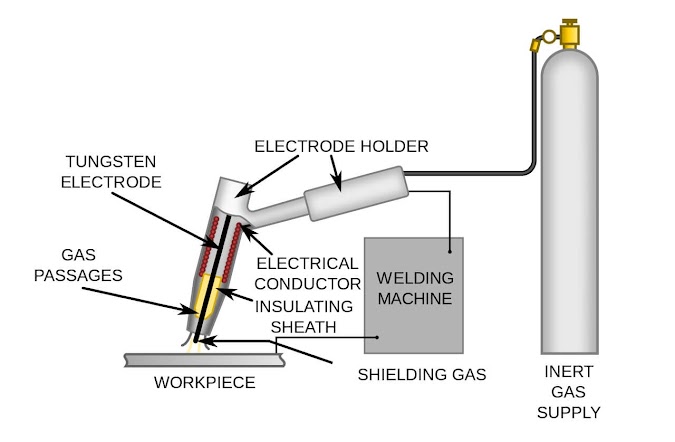Explain Tungsten Inert Gas (TIG) Welding Process
🔗Standard welding terms and definitions
🔗MIG Welding Process, Basic Components
TIG welding, also known as Gas Tungsten Arc Welding (GTAW), is a type of arc welding that uses a non-consumable tungsten electrode. The tungsten electrode is held in a hand-held torch, and an inert gas shield protects the weld area from oxidation. Gas is ducted directly to the weld zone, where it surrounds the tungsten electrode. Typically argon and helium or mixture of both gases are the most commonly used inert gases in TIG welding. When helium is used, this is known as heliarc welding.
The filler material is supplied externally in the form of filler wire. The intense electric arc between a tungsten electrode and the metal workpiece provides the necessary heat to melt the filler metal wire. Welding rods fed into a weld zone will melt the same way they do with oxyacetylene welding. A stable and constant arc gap is maintained at a constant current level. For welding of metals with different characteristics, either DC current at 200 amps or AC current at 500 amps is used. AC current helps remove oxides from the weld and improves weld quality. The tungsten electrode doesn't melt during the process, so it doesn't fuse to the weld.
🔗Difference between TIG welding and MIG welding
TIG welding is a process that requires a specific set of equipment and setup to execute properly. The equipment used for TIG welding is shown in Figure. The various components of this equipment are a welding torch, tungsten electrode, filler rod, power source, high-frequency DC unit, and inert gas cylinder. The TIG welder should be set to the appropriate amperage and voltage for the metal being welded. The tungsten electrode should be inserted into the torch, and the inert gas should be turned on.
TIG welding is a highly skilled process that is used for welding thin materials, dissimilar metals, and precision welding. It is also often used to create high-quality, attractive welds on stainless steel, aluminium, and other non-ferrous metals.
Read: Applications, advantages and disadvantages of TIG welding


